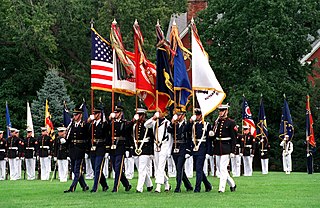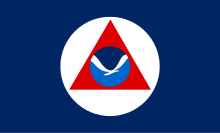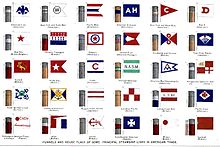Flag terminology is the nomenclature, or system of terms, used in vexillology, the study of flags, to describe precisely the parts, patterns, and other attributes of flags and their display.

The ensign is a maritime flag that is used for the national identification of a ship. The ensign is the largest flag, generally flown at the stern (rear) of the ship while in port. In ports, depending on the ship's origin, it is sometimes identical with a jack on the bow of the ship. Jacks are more common on warships than on merchant ships.

The several branches of the United States Armed Forces are represented by flags. Within the U.S. military, various flags fly on various occasions, and on various ships, bases, camps, and military academies.

The White Ensign, at one time called the St George's Ensign because of the simultaneous existence of a crossless version of the flag, is an ensign worn on British Royal Navy ships and shore establishments. It consists of a red St George's Cross on a white field, identical to the flag of England except with the Union Flag in the upper canton.

A jack is a flag flown from a short jackstaff at the bow (front) of a vessel, while the ensign is flown on the stern (rear). Jacks on bowsprits or foremasts appeared in the 17th century. A country may have different jacks for different purposes, especially when the naval jack is forbidden to other vessels. The United Kingdom has an official civil jack; the Netherlands has several unofficial ones. In some countries, ships of other government institutions may fly the naval jack, e.g. the ships of the United States Coast Guard and the National Oceanic and Atmospheric Administration in the case of the US jack. Certain organs of the UK's government have their own departmental jacks. Commercial or pleasure craft may fly the flag of an administrative division or municipality at the bow. Merchant ships may fly a house flag. Yachts may fly a club burgee or officer's flag or the owner's private signal at the bow. Practice may be regulated by law, custom, or personal judgment.

The commissioning pennant is a pennant flown from the masthead of a warship. The history of flying a commissioning pennant dates back to the days of chivalry with their trail pendants being flown from the mastheads of ships they commanded. Today, the commissioning pennants are hoisted on the day of commissioning and not struck until they are decommissioned. Some navies have a custom of flying a "paying off" or "decommissioning pennant," the length of which often reflects the length of service of the warship.

Striking the colors—meaning lowering the flag that signifies a ship's or garrison's allegiance—is a universally recognized indication of surrender, particularly for ships at sea. For a ship, surrender is dated from the time the ensign is struck.

The First Navy Jack was the naval jack of the United States from 1975 to 1976 and again from 2002 to 2019. It was authorized by the U.S. Navy and was flown from the jackstaff of commissioned vessels of the U.S. Navy while moored pierside or at anchor. Since then, it is used only as a naval jack by the oldest active warship in the U.S. Navy. The design is traditionally regarded as that of the first U.S. naval jack, flown soon after independence, but this is not supported by the historical record.
This glossary of nautical terms is an alphabetical listing of terms and expressions connected with ships, shipping, seamanship and navigation on water. Some remain current, while many date from the 17th to 19th centuries. The word nautical derives from the Latin nauticus, from Greek nautikos, from nautēs: "sailor", from naus: "ship".

A pennon, also known as a pennant or pendant, is a long narrow flag which is larger at the hoist than at the fly. It can have several shapes, such as triangular, tapering or triangular swallowtail, etc. In maritime use, pennants are to be hung from the main truck.

A battle ensign is the name given to a large war ensign (flag) hoisted on a warship's mast just before going into battle.

The jack of the United States, referred to as the Union Jack by the U.S. Navy, is a maritime jack flag flown on the bow of U.S. vessels that are moored or anchored. In addition to commissioned U.S. Navy ships, the jack is used by the U.S. Coast Guard, the Military Sealift Command, the ships of the National Oceanic and Atmospheric Administration, and other U.S. government entities. While anchored or moored, the jack is flown on the bow of a ship, and the ensign is flown on the stern. Once under way, the jack is lowered.

A burgee is a distinguishing flag, regardless of its shape, of a recreational boating organization. In most cases, they have the shape of a pennant.

A French ensign is the flag flown at sea to identify a vessel as French. Several such ensigns have existed over the years as well as terrestrial flags based on the ensign motif.

A broad pennant is a triangular swallow-tailed naval pennant flown from the masthead of a warship afloat or a naval headquarters ashore to indicate the presence of either:

The ensign of the United States is the flag of the United States when worn as an ensign. International maritime law—see International Treaty on Law of the Sea, articles 91 and 92—provides that vessels have a "national character" and thus should display a flag (ensign) that corresponds to this national character, especially when in international or foreign waters. Vessels that are formally documented under the federal vessel documentation act, vessels owned by government bodies in the United States, and vessels in the U.S. military unquestionably have U.S. national character, and thus properly hoist a U.S. ensign to show their national character. Vessels that are numbered by the states and small, non-registered craft owned by U.S. citizens and not registered in other countries may also hoist a U.S. ensign to show their national character.

There are many customs and traditions associated with the Royal Navy of the United Kingdom. Many of these traditions have carried on to other Commonwealth navies, such as Canada, India, Australia and New Zealand. These include formal customs such as separate crests associated with ships, ensigns and fleet reviews. There are also several less formal customs and traditions, including Naval slang commonly referred to as Jack Speak and the traditional games of Uckers and Euchre.

Dressing overall consists of stringing international maritime signal flags on a ship from stemhead to masthead, from masthead to masthead and then down to the taffrail. It is a sign of celebration, and is done for celebratory occasions, anniversaries and events, whether national, local or personal.

The gin pennant is a maritime flag. When flown aboard ship, it indicates an open invitation to other ships' officers to come aboard for drinks.




























